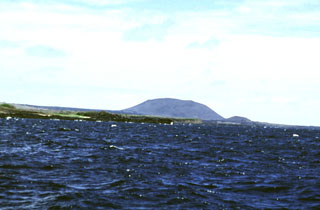Report on Marchena (Ecuador) — October 1991
Bulletin of the Global Volcanism Network, vol. 16, no. 10 (October 1991)
Managing Editor: Lindsay McClelland.
Marchena (Ecuador) Flow front advances into sea with no explosive venting
Please cite this report as:
Global Volcanism Program, 1991. Report on Marchena (Ecuador) (McClelland, L., ed.). Bulletin of the Global Volcanism Network, 16:10. Smithsonian Institution. https://doi.org/10.5479/si.GVP.BGVN199110-353080
Marchena
Ecuador
0.33°N, 90.47°W; summit elev. 343 m
All times are local (unless otherwise noted)
[The eruption] has continued without explosive venting visible from a distance. Observers on a boat that passed Marchena on 7 or 8 November reported vigorous steaming at the W coast. Water near the flow front was too hot to touch and numerous fumaroles were evident inland. Since David Day's 28-30 September visit, lava had formed a single broad front at the coast, closing the small bay where Day had landed.
Reports collected by Day provided additional information about the timing and characteristics of the early phases of the eruption. The first reported activity was a "suspicious" large cloud seen over Marchena on 25 September at 1840 from ~65 km S (at Bartolomé). An explosion was observed at 1905 from ~90 km SSE (Turtle Cove, Santa Cruz Island). A low white cloud near the coast was seen with infrared binoculars at about 2100. Witnesses at three sites ~65 km S reported 7-8 evenly spaced vents that remained active throughout the night. Incandescent ejecta appeared to rise roughly the equivalent of the island's elevation (~350 m), with height increases of ~25% during the strongest activity. A more vigorous vent, lying W of the others, was first seen at about 0300 on 26 September. Ejecta heights from the W vent appeared to exceed those from the other vents by ~50%.
Geological Summary. The low shield volcano forming Marchena Island contains one of the largest calderas of the Galápagos Islands. The 6 x 7 km caldera and its outer flanks have been largely buried by a cluster of pyroclastic cones and associated lava flows. Its first historical eruption occurred in 1991. Other young lava flows, some of which may be only a few thousand, or even a few hundred years old, filled the caldera and flowed down its outer forested flanks, in some cases to the sea.
Information Contacts: D. Day, Isla Santa Cruz.

